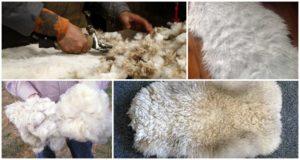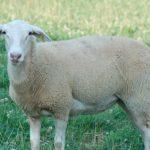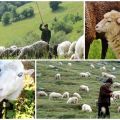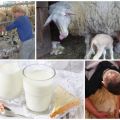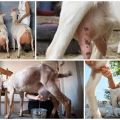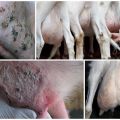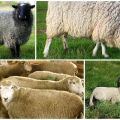Description and characteristics of lacon sheep, requirements for their maintenance
The most widespread sheep of the Lacon breed (Lakayune) received in France. During the year, these animals give slightly less milk than the East Frisian breed, but the nutritional properties of the former are higher. For example, lacon sheep milk is used to make the famous Roquefort cheese. Breeding this breed is a necessary and demanded activity, therefore scientists are constantly working to improve it, strive to increase productivity.
Description and characteristics of the lacon
The origin of this breed is France. At first, the lakayune had low productivity, were demanding in terms of care and maintenance. But after years of careful selection, they began to give more milk, gained resistance to various diseases.
Animals are raised only for milk production, less often they are used for food (only lamb, since the meat of adult sheep is completely tasteless). They are also not suitable for obtaining wool, since the volume of the latter is significantly less compared to other breeds. The number of sheep in the world exceeds 1 million. Lacon is the finest dairy breed in France, and it got its name from the Mont de Lacon district.
The characteristics of the appearance of the varnish are as follows:
- Medium to large sizes. The average weight of rams varies between 80-100 kilograms, while sheep weigh 55-60 kilograms.
- Wool is white, fine in structure. In this case, the head is bare.
- Horns are absent (except for the 2 cm horns that males have).
- The muzzle is elongated, thin.
- The tail is long and thin.
- The height at the withers in rams is 75 centimeters, in sheep - 70 centimeters.
- The back of the body is well muscled.
- The chest is deep.

It is noteworthy that male lacons are used to improve other breeds.
Advantages and disadvantages
Requirements for maintenance and care
This breed is unpretentious, but in order to achieve high productivity, it is important to provide the animals with quality care. The conditions for keeping sheep lacon are as follows:
- In the summer, the sheep are sent out for a walk (during the day) and driven into pens (at night).During cold weather, livestock are kept in a sheepfold.
- It is advisable to keep lactating females in separate stalls. Place a heater if necessary. It is also very important to regularly clean the room and periodically ventilate it.
- Prepare carefully for the milking process. To do this, you will need specially equipped corrals with an entrance and an exit. The size of the room must match the size of the animal. It is important that the floor has a slightly inclined plane - due to this, the head of the animal will be higher than the legs during milking. This will ensure that the animal behaves calmly.
The milking process itself includes the following steps:
- Sit on a chair to the side of the sheep.
- Place a container under the udder.
- Cover the container with clean gauze folded in half.
- Knead the udder.
- Start milking: take 2 teats and squeeze alternately with your fingers.
- Next, move on to the next nipples.
- At the end of the procedure, the udder is washed with warm water and wiped with a towel.
- Filter the milk again.
You also need to follow the rules:
- before starting the procedure, the container must be thoroughly washed, the same applies to the hands of the milkmaid;
- wash the udder with warm water;
- pour the first streams of milk into a separate container to check its quality;
- the milking process takes a few minutes.

Feeding
The diet of representatives of the lacon consists mainly of pasture (grass, grain). The menu is also diversified with special compound feed.
In winter, hay and silage and root crops are important. The animals are fed 3-4 times a day.
Breeding subtleties
Lakayune is an early maturing breed: females reach sexual maturity at 7-10 months and are already ready to mate. On average, 100 lacon sheep yield 131 lambs. The gestation period is 145 days. Most often there are no more than 2 lambs in one litter. The next pregnancy occurs in 1 year (in November-January). Lactation of lambs lasts about a month, after which the weight of young animals reaches 15 kilograms. Lacon sheep have a lifespan of about 25 years.
Possible diseases
Representatives of the lacon are characterized by increased resistance to diseases, parasite infestation. However, like most dairy breeds, Lakayune are prone to mastitis. This disease is the basis for culling sheep.
Lacon is one of the best and most popular dairy sheep breeds. Breeding livestock is a profitable business if you approach it seriously and thoroughly.
